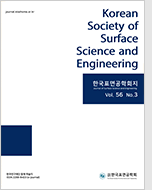
- Past Issues
- e-Submission
-

2021 Impact Factor 1.766
5-Year Impact Factor 1.674
Editorial Office
- +82-2-563-0935
- +82-2-558-2230
- submission@kssse.or.kr
- https://www.kssse.or.kr/

2021 Impact Factor 1.766
5-Year Impact Factor 1.674
The Korean Society of Surface Science and Engineering 2023;56(6):401-411. Published online: Dec, 28, 2023
DOI : 10.5695/JSSE.2023.56.6.401
This study investigates the synthesis, characterization, and application of zinc oxide (ZnO) nanoparticles for corrosion resistance and stress corrosion cracking (SCC) mitigation in high-temperature and high-pressure environments. The ZnO nanoparticles are synthesized using plasma discharge in water, resulting in rod-shaped particles with a hexagonal crystal structure. The ZnO nanoparticles are applied to Alloy 600 tubes in simulated nuclear power plant atmospheres to evaluate their effectiveness. X-ray diffraction and X-ray photoelectron spectroscopy analysis reveals the formation of thermodynamically stable ZnCr2O4 and ZnFe2O4 spinel phases with a depth of approximately 35 nm on the surface after 240 hours of treatment. Stress corrosion cracking (SCC) mitigation experiments reveal that ZnO treatment enhances thermal and mechanical stability. The ZnO-treated specimens exhibit increased maximum temperature tolerance up to 310 °C and higher-pressure resistance up to 60 bar compared to non-treated ZnO samples. Measurements of crack length indicate reduced crack propagation in ZnO-treated specimens. The formation of thermodynamically stable Zn spinel structures on the surface of Alloy 600 and the subsequent improvements in surface properties contribute to the enhanced durability and performance of the material in challenging high-temperature and high-pressure environments. These findings have significant implications for the development of corrosion-resistant materials and the mitigation of stress corrosion cracking in various industries.
Keywords SCC, ZnO nanoparticle, ECP, Spinel structure, PWR, Alloy 600